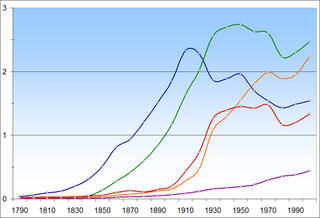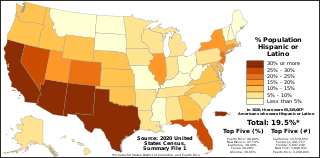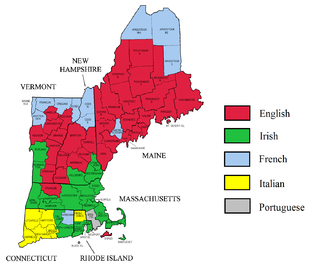Hispanic or Latino by national origin
| Ancestry by origin [6] | Number | % |
|---|---|---|
| | 1,078,084 | |
| | 851,630 | |
| | 464,480 | |
| | 271,016 | |
| | 178,792 | |
| | 164,584 | |
Hispanic and Latino New Yorkers are residents of the state of New York who are of Hispanic or Latino ancestry. As of 2013, Hispanics and Latinos of any race were 18.4% of the state's population. [1] The Hispanic and Latino population is especially large in New York City, where the 2.49 million Hispanics (as defined by the U.S. Census) make up 28.3% of the city's population, the second-largest population group second only to non-Hispanic whites at 30.9.%. [2]
The first Hispanic presence in New York may have been that of the Portuguese explorer's troops Estêvão Gomes, who served the Castilian Crown. In 1524 Gomes may have entered New York Harbor and seen the Hudson River. The first Hispanic to emigrate to the modern-day New York was the Dominican Juan Rodriguez. He was a member of the crew of the Dutch ship Jonge Tobias, which reached New York City in 1613, and he lived there for a while, being the first non-Native American to reside in the region. [3] Another early settler with Hispanic and Moorish, as well as Dutch, roots was Anthony Janszoon van Salee.
Puerto Rican migration to New York began in the 19th century and became the largest Hispanic group to migrate to the state. This migration increased in 1917 with the enactment of the Jones-Shafroth Act, which granted U.S. citizenship to all Puerto Ricans, [4] and especially in the 1940s and 1950s. [5]
| Ancestry by origin [6] | Number | % |
|---|---|---|
| | 1,078,084 | |
| | 851,630 | |
| | 464,480 | |
| | 271,016 | |
| | 178,792 | |
| | 164,584 | |
The New York City borough of the Bronx is majority Hispanic. [2] The first Hispanic Borough President of the Bronx was Herman Badillo in the 1960s.
The city of Haverstraw is the most-Hispanic or Latino city in New York, with 67% of the population identifying as Hispanic or Latino. [7]

The population of Puerto Rico has been shaped by native American settlement, European colonization especially under the Spanish Empire, slavery and economic migration. Demographic features of the population of Puerto Rico include population density, ethnicity, education of the populace, health of the populace, economic status, religious affiliations and other aspects of the population.

Puerto Ricans, most commonly known as Boricuas, but also occasionally referred to as Borinqueños, Borincanos, or Puertorros, are an ethnic group native to the Caribbean archipelago and island of Puerto Rico, and a nation identified with the Commonwealth of Puerto Rico through ancestry, culture, or history. Puerto Ricans are predominately a tri-racial, Spanish-speaking, Christian society, descending in varying degrees from Indigenous Taíno natives, Southwestern European colonists, and West and Central African slaves, freedmen, and free Blacks. As citizens of a U.S. territory, Puerto Ricans have automatic birthright American citizenship, and are considerably influenced by American culture. The population of Puerto Ricans is between 9 and 10 million worldwide, with the overwhelming majority residing in Puerto Rico and mainland United States.

Nuyorican is a portmanteau word blending "New York" and "Puerto Rican", referring to Puerto Ricans located in or around New York City, their culture, or their descendants. This term is sometimes used for Puerto Ricans living in other areas in the Northeastern US Mainland outside New York State as well. The term is also used by Islander Puerto Ricans to differentiate those of Puerto Rican descent from the Puerto Rico–born.

Dominican Americans are Americans who trace their ancestry to the Dominican Republic. The phrase may refer to someone born in the United States of Dominican descent or to someone who has migrated to the United States from the Dominican Republic. As of 2021, there were approximately 2.4 million people of Dominican descent in the United States, including both native and foreign-born. They are the second largest Hispanic group in the Northeastern region of the United States after Puerto Ricans, and the fifth-largest Hispanic/Latino group nationwide.

Puerto Ricans have both immigrated and migrated to New York City. The first group of Puerto Ricans immigrated to New York City in the mid-19th century when Puerto Rico was a Spanish colony and its people Spanish subjects. The following wave of Puerto Ricans to move to New York City did so after the Spanish–American War in 1898. Puerto Ricans were no longer Spanish subjects and citizens of Spain, they were now Puerto Rican citizens of an American possession and needed passports to travel to the Contiguous United States.

At the 2010 census, there were 1,526,006 people, 590,071 households, and 352,272 families residing in the consolidated city-county of Philadelphia, Pennsylvania. The population density was 4,337.3 people/km2. There were 661,958 housing units at an average density of 1,891.9 units/km2.

New York County, coterminous with the New York City borough of Manhattan, is the most densely populated U.S. county, with a density of 70,825.6/sq mi (27,345.9/km2) as of 2013. In 1910, it reached a peak of 101,548/sq mi (39,208/km2). The county is one of the original counties of New York State.

The demographics of Queens, the second-most populous borough in New York City, are highly diverse. No racial or ethnic group holds a majority in the borough.
The demographics of the Bronx are characterized by a Hispanic majority and by the lowest percentage of Whites among all boroughs.

Richmond County, also known as Staten Island, is a borough of New York City, New York, United States. Staten Island is the least populated of the five boroughs, with 475,000 people, but is the third largest in area, at 59 sq mi (153 km2).

Stateside Puerto Ricans, also ambiguously known as Puerto Rican Americans, or Puerto Ricans in the United States, are Puerto Ricans who are in the United States proper of the 50 states and the District of Columbia who were born in or trace any family ancestry to the unincorporated US territory of Puerto Rico.

According to the U.S. Census Bureau, as of 2023, New York was the fourth largest state in population after California, Texas, and Florida, with a population of 19,571,216, a decrease of over 600,000 people, or −3.1%, since the 2020 census. The population change between 2000–2006 includes a natural increase of 601,779 people and a decrease due to net migration of 422,481 people out of the state. Immigration from outside the United States resulted in a net increase of 820,388 people, and migration within the country produced a net loss of about 800,213.

Caribbean Americans or West Indian Americans are Americans who trace their ancestry to the Caribbean. Caribbean Americans are a multi-ethnic and multi-racial group that trace their ancestry further in time mostly to Africa, as well as Asia, the Indigenous peoples of the Americas, and to Europe. As of 2016, about 13 million — about 4% of the total U.S. population — have Caribbean ancestry.

Since its founding in 1625 by Dutch traders as New Amsterdam, New York City has been a major destination for immigrants of many nationalities who have formed ethnic enclaves, neighborhoods dominated by one ethnicity. Freed African American slaves also moved to New York City in the Great Migration and the later Second Great Migration and formed ethnic enclaves. These neighborhoods are set apart from the main city by differences such as food, goods for sale, or even language. Ethnic enclaves provide inhabitants security in work and social opportunities, but limit economic opportunities, do not encourage the development of English speaking, and keep immigrants in their own culture.

The demographics of Hispanic and Latino Americans depict a population that is the second-largest ethnic group in the United States, 62 million people or 18.7% of the national population.

According to the 2018 American Community Survey, New England had an estimated population of 14,853,290, of which 48.7% were male and 51.3% were female. Approximately 19.7% of the population were under 18 years of age; 17.4% were 65 years of age or over.
Caribbean immigration to New York City has been prevalent since the late 19th and the early 20th centuries. This immigration wave has seen large numbers of people from Jamaica, Haiti, Cuba, Dominican Republic, Antigua and Barbuda, Guyana, and Trinidad and Tobago, among others, come to New York City in the 20th and 21st centuries. Caribbeans are concentrated in the Bronx, from 211th Street to 241st Street and Gun Hill Road. There are also Caribbean communities in Brooklyn, especially in the neighborhoods of Flatbush and Prospect Heights.
Hispanic and Latino Floridians are residents of the state of Florida who are of Hispanic or Latino ancestry. The statistics in the PEW report show that the justification of the definition of “Hispanic” is based on Spanish language in Latin America or if a person is from Spain, while Latino is based on Latin American origin disregarding people from Spain or Portugal. The same study presented the findings 27% preferred to identify as “Hispanic” while 18% preferred the term “Latino”. The Census Bureau has changed its framed terminology towards the question since it was first introduced in 1930 as a “Mexican Race” option and it is still changing to this day to become more inclusive and specific to each person who identifies as Hispanic and/or Latino. Latinos in Florida accounted for 5.3 million of the US Latino population. At around 28.5% of the population as of 2017, Cubans are the largest Latino group in Florida. Puerto Ricans are one of the fastest growing Latino groups in Florida, with one out of every five Latinos in the state being of Puerto Rican origin. Cubans and Puerto Ricans together make up almost half of Florida's Latino population. Other sizable Latino groups include South Americans (17.9%), Mexicans (13.5%), Central Americans (10.7%), and Dominicans (4.8%); all other Latinos make up 3.6% in total.

The city of New York includes a sizeable Dominican population. Dominicans are one of the largest Latino groups in New York City followed by Puerto Ricans. Dominicans are the largest immigrant group in New York City. Dominicans are concentrated in Washington Heights and the Bronx in the city proper; by 2019, the share living in the city fell from 92% to 62%. The rest lived in outlying counties in the metro area. Census Bureau’s 2019 American Community Survey found that 702,000 Dominicans live in New York City.
According to the 2020 U.S. Census, there were a total of 8,804,190 residents in New York City. A total of 2,719,856 residents identified as Non-Hispanic White, followed by 2,490,350 people of Hispanic origin (28.3%), 1,776,891 Black residents (20.2%) and 1,373,502 people of Asian origin (15.6%). A total of 143,632 residents identified with a different race (1.6%), while 299,959 identified with two or more races (3.4%).